Remembering the Annex Building as Location turns into Parking Lot
“TRAX Red Line to Daybreak at Fort Douglas Station” by vxla is licensed under CC BY 2.0
July 8, 2021
After over 70 years of operation, the demolition of the Annex building began on June 24, 2021. From housing classrooms and offices to once holding the world’s largest collection of turtles, the building has served a variety of purposes.
Built in 1942, originally the Annex building was a part of Fort Douglas. Construction took a total of 90 days, and it was meant to be a temporary building.
With the building’s long history, it has seen many students, faculty and staff pass through. Many people have fond memories of their time spent in the Annex building.
“It was a great building, with a sense of history,” said University of Utah alumni Edye Hoffmann. “[It had] very little air conditioning, so the doors were always open and people were very accessible.”
The Annex was first used as an administrative building and headquarters for the Ninth Service Area of the U.S. Army, which commanded Alaska, California, Idaho, Montana, Nevada, Oregon, Washington and Utah.
In 1948 the building was given to the U by the U.S. War Department. This decision was made by General Dwight D. Eisenhower, later president, who noticed the growing number of students enrolling at the U and its need for extra space.
Over the decades, the building housed many different campus departments. One of these was the U’s TRIO program.
“I worked for TRIO in the Annex,” said U alumni Amy Damian. “I mainly remember liking how there [were not] many people in the building, so you would have the bathroom to yourself. Also, our office felt very homey, kind of like a living room.”
Another department that was once housed in the Annex building was the English Language Institute, where Hoffmann worked during her time as a student.
“It really was a fun place to work,” Hoffmann said. “There were a lot of opportunities for temporary people to come around. A lot of students [took] internships in short periods, [so] I had the chance to meet a lot of people and a lot of different departments.”
Though the building held a special place in many people’s memories, it did not come without its problems. With the building’s age came many issues. According to Damian, the only form of heating the building had was old space heaters in each room.
“Each little room [in the building] had its own heater,” Damian said. “If you closed the door, it would be so hot that you would have to turn [the heater] off, but if you kept everything open and cracked the window, it felt fine.”
Along with difficulty maintaining a comfortable temperature, the classrooms in the Annex building often did not have enough space to support an entire class.
“The [classrooms] were so small that there were students who would be in the hall or have to bring chairs [in] from other rooms,” Damian said.
These issues were not the only thing to haunt the World War II-era building. Some of the people who worked and studied at the Annex building rumored that it may be home to ghosts.
“I remember stories of the basement and how creepy it was down there,” Damian said. “There were stories that there were ghosts, but [I think] it was all maintenance people. I only ever saw the entrance [of the basement], never actually went down.”
The destruction of the Annex building begins a new chapter of its history, as it is planned to be replaced with a parking lot.
“I think [turning it into a parking lot] is a wise decision,” said Damian. “The building was old, and it was time for all the offices in there to upgrade to newer spaces.”
With the U’s growing number of students, faculty and staff, this future parking lot will welcome countless drivers, not realizing that they are parking on history.








